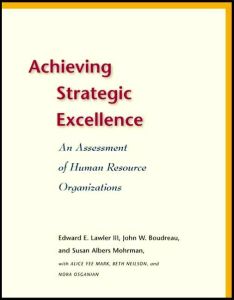Join getAbstract to access the summary!

Join getAbstract to access the summary!
Edward E. Lawler, John W. Boudreau and Susan Albers Mohrman
Achieving Strategic Excellence
An Assessment of Human Resource Organizations
Stanford UP, 2006
What's inside?
How the role of human resources grew from 1995 to 2004: Hard data on what HR was, could be and should become.
Recommendation
Between 1995 and 2004, the Center for Effective Organizations conducted periodic surveys of the role of human resource departments in large U.S. corporations. Edward E. Lawler III, John W. Boudreau, Susan Albers Mohrman and other researchers, analyze that study in this useful book. Although their style can get dry and academic (perhaps since they are all university faculty members), this work is by no means purely theoretical. It includes applicable, real-world information that shows how HR managers and other corporate leaders perceive the changing role of the organizational HR department. This study says corporate leaders have come to realize that human resource work adds strategic value, given the importance of skilled personnel. It is no news to insiders that HR has become far more than a cost center, but these authors explain why. getAbstract recommends this work to HR managers and other executives who have a professional and intellectual need to stay on top of HR trends – and who will fearlessly take on tables, statistics and the halls of academe in the quest for that knowledge.
Summary
About the Authors
The authors are affiliated with the University of Southern California. Edward E. Lawler III, distinguished professor of business, has written books on business process outsourcing and strategic HR organizations. John W. Boudreau, a professor and research director, has written more than 50 books and articles. Susan Albers Mohrman, a senior research scientist, is a past board member of the HR Planning Society and the Academy of Management.





















Comment on this summary